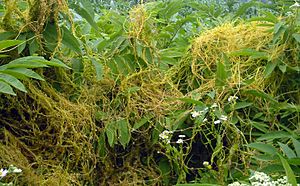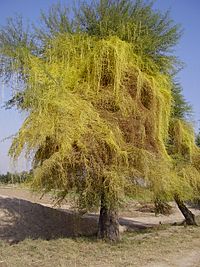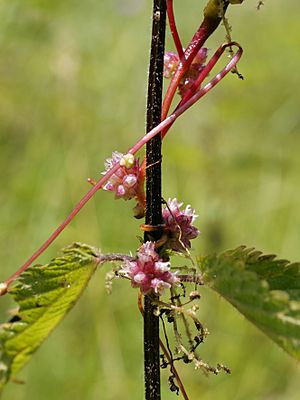Dodder facts for kids
Quick facts for kids Dodder |
|
|---|---|
 |
|
| Dodder on a Danewort | |
| Scientific classification | |
| Kingdom: | |
| (unranked): | |
| (unranked): | |
| (unranked): | |
| Order: | |
| Family: | |
| Genus: |
Cuscuta
|
| Species | |
|
about 100–170 species |
|
Dodder, also known as Cuscuta, is a unique group of plants. It includes about 100 to 170 different types. These plants are special because they are parasitic flowering plants. This means they get their food from other plants.
Scientists have studied Dodder's genes. They found it belongs to the morning glory family, called Convolvulaceae. You can find Dodder plants all over the world. They grow in both warm and mild areas. Most types of Dodder prefer warmer, subtropical and tropical places. Only a few types grow in cooler parts of the world, like northern Europe.
Contents
What Does Dodder Look Like?
Dodder plants are easy to spot by their thin stems. They often look like they have no leaves. Their leaves are actually tiny scales.
From summer to early autumn, these vines can grow small fruits. The fruits are the same color as the vine. They are usually about the size of a pea. Dodder plants have very little chlorophyll. Chlorophyll is what makes most plants green. Some Dodder types, like Cuscuta reflexa, can do a little photosynthesis. This means they can make some of their own food. But others, like C. europaea, rely completely on other plants for food.
Dodder flowers come in many colors. They can be white, pink, yellow, or cream. Some species bloom in early summer. Others flower later in the season. Dodder seeds are very small. The plant makes a lot of them. These seeds have a hard outer layer. This lets them survive in the soil for 5 to 10 years or even longer.
How Dodder Lives and Grows
Dodder seeds usually sprout near the ground. A seed can start growing without a host plant. But the young Dodder plant must find a green plant quickly. Dodder seedlings can actually grow towards the smell of nearby plants.

If a Dodder seedling does not find a plant within 5 to 10 days, it will die. Before it finds a host, the Dodder uses food stored inside its embryo. Its first leaves, called cotyledons, are very tiny.
How Dodder Becomes a Parasite
Once Dodder finds a plant, it wraps itself around it. If the host plant has useful food, the Dodder grows special parts. These are called 'haustoria'. They push into the host plant. After this, the Dodder's original root in the soil dies.
A single Dodder plant can grow very long. It can attach itself to many different plants. In warm, tropical areas, Dodder can grow all the time. It can even reach high into the tops of shrubs and trees. In cooler, temperate places, Dodder lives for only one year. It stays on low plants that new seedlings can reach each spring.
Dodder can be a parasite on many kinds of plants. This includes many farm and garden plants. Some examples are alfalfa, flax, clover, potatoes, chrysanthemum, dahlia, trumpet vine, ivy, and petunias.
Images for kids
-
Cuscuta on a Chinese date tree in Punjab, India
-
Cuscuta on sage in the Mojave Desert
See also
 In Spanish: Cuscuta para niños
In Spanish: Cuscuta para niños











